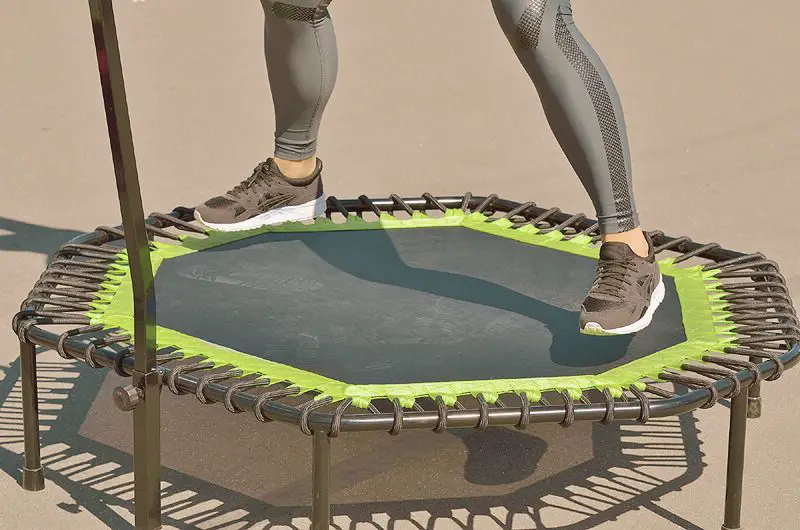When bouncing on a trampoline, the sensation of tingling in the feet and calves can often arise, leaving many curious about its cause. This tingling sensation is primarily attributed to the repetitive impact and pressure exerted on the feet and lower legs while jumping. As the body repeatedly compresses and decompresses against the trampoline surface, it can momentarily impede blood circulation to these areas, leading to a tingling or pins-and-needles sensation.
The continuous bouncing motion can engage and stimulate the nerves in the feet and calves, contributing to the tingling sensation. While this phenomenon is usually temporary and harmless, it’s essential to practice caution and moderation when using a trampoline to minimize any discomfort or potential injury.
How Trampolines Work: Elasticity and Rebound Effect
A trampoline mat is made of tightly woven fabric infused with rubber bands underneath. This elasticity allows the mat to stretch downwards to absorb the body’s momentum on landing, before recoiling upwards to propel the jumper high on the next bounce via the “rebound effect.”
The cyclic absorption and release of kinetic energy makes jumping on a trampoline very efficient, allowing people to reach greater heights than by jumping on solid ground.
Impact on Body: Forces Experienced by Feet and Calves
With each landing, the body undergoes rapidly changing forces. Feet and calves touch down with considerable impact as they decelerate from the air. The mat then stretches to cushion and briefly support body weight before catapulting feet and calves upwards again.
These alternating cycles of high impact and assisted rebound are intrinsic to trampoline mechanics. But they also place significant repetitive loads on feet and lower legs.
Connection: Trampoline Mechanics and Tingling Sensations
The tingling felt in feet and calves likely arises from how trampoline bouncing affects structures and systems in those areas. To understand why tingling occurs, we must explore the neurological and circulatory factors influenced by those repetitive impacts and rebounds.
Explanation of Tingling Sensation: Nerves, Signals, and Perception
Tingling represents unusual somatic sensations, often described as prickling or creeping skin. This arises from mixed signals in the nervous system, typically when nerves become overly compressed, stretched, or irritated. The body’s proprioceptive system also plays a key role.
Proprioception: Body Awareness in Space
Proprioception refers to our body’s internal sense allowing it to adjust and coordinate without visual input. This “sixth sense” relies on receptors throughout muscles, joints, and tendons to continually relay positional information to the brain.
Proprioception enables graceful control of body movements by integrating signals about equilibrium, pressure, tension, and limb placement. Robust proprioceptive feedback is even more vital when vision is impaired, as when jumping with eyes closed on a trampoline.
If proprioceptive signals from the feet and calves are disrupted, the brain struggles to track positioning. Faulty feedback along these neural pathways could manifest as tingling sensations. Let’s explore two mechanisms by which trampoline bouncing may interfere with neurological signaling.

Potential Factors Influencing Tingling on a Trampoline
When considering potential factors influencing tingling sensations experienced on a trampoline, several physiological and biomechanical factors come into play. Two significant aspects to explore are blood circulation and compression, as well as nerve compression and irritation.
Blood Circulation and Compression
Blood circulation is the process by which oxygen, nutrients, and other essential substances are transported throughout the body via the cardiovascular system. The heart acts as the central pump, sending oxygen-rich blood through arteries to tissues and organs, while veins return oxygen-depleted blood back to the heart for oxygenation in the lungs.
Blood Circulation in Extremities
Oxygenated blood circulates body-wide through arteries, while veins return deoxygenated blood to the heart and lungs. Narrow arterioles and capillaries connect the two systems at the extremities. Healthy circulation provides oxygen and nutrients to these distant sites like feet and calves.
Compression Effects on Blood Flow
The sheer act of bouncing may impede blood flow by mechanically compressing arteries and veins with each footstrike. Studies on runners show how repeated impacts can temporarily kink blood vessels. Such compression could lead to mild hypoxia and accumulation of metabolic waste in lower limb tissue.
Relationship with Tingling Sensation
If oxygen depletion or toxin buildup in feet/calves crosses a threshold, it may trigger unusual neurological signals – felt as tingling or prickling. Supporting this theory, tingling often starts after prolonged trampoline use and may persist for a short while even after stopping.
Nerve Compression and Irritation
Nerve compression and irritation can occur while bouncing on a trampoline due to various factors.
Nerve Anatomy in Feet and Calves
The lower limbs contain bundles of sensory and motor nerves branching from the lumbar/sacral plexus. These nerves control fine foot and calf movements while providing positional feedback.
Nerve Compression
Repeated trampoline bouncing likely overloads these neurological structures. Besides experiencing direct impact, nerves may be pinched by compressed tissues. Such mechanical irritation could interfere with proprioceptive signaling.
Nerve Irritation
Persistent exposure to traction, friction and awkward angles during use can stress neural structures. Nerve irritation tends to worsen over extended bouncing sessions as protective sheaths become inflamed.
Both nerve compression and irritation could generate aberrant signaling patterns to the brain, creating tingling sensations as a symptom. Stopping activity allows nerves to recover, so this may explain why tingling is temporary.
Impact of Jumping Technique and Duration
The sensation of tingling in feet and calves while on a trampoline can be influenced by jumping technique and duration. Incorrect form or excessive jumping without breaks may strain muscles, compress nerves, or impede blood flow, leading to tingling sensations.
Proper Jumping Form
The style and method of bouncing can either exacerbate or help prevent foot and calf tingling. Properly flexing joints like knees and ankles while jumping absorbs impacts through the muscles. This protects nerves/vessels from excessive squash-and-stretch effects. Meanwhile, rigid jumping with locked joints directly transmits trampoline forces through the limbs.
Duration and Tingling
Research on aerobic exercise shows tingling sensations tend to manifest only after substantial time and repetition. This suggests trampoline jumping follows a “dose-dependent” relationship between activity duration and nerve/circulatory irritation.
The longer someone continues bouncing without rest, the more likely tissue irritation will occur and cross the threshold for bothersome tingling feelings.
Strategies via Technique and Moderation
Using proper jumping form helps delay the onset of tingling by protecting nerves and blood vessels inside flexed limbs acting as shock absorbers. Additionally, limiting single bouncing sessions prevents overuse irritation.
Taking short breaks every 10-15 minutes can restore normal circulation and neural function before jumping again. Take care to land softly with bent knees after any pause.

Pre-existing Conditions and Sensitivity
Pre-existing conditions and sensitivity can exacerbate tingling sensations in feet and calves on a trampoline. Conditions like neuropathy or poor circulation heighten nerve response to the bouncing motion, intensifying tingling. Sensitivity to pressure points and impact may also contribute, highlighting the importance of caution and awareness for individuals with such conditions.
Relevant Conditions
Certain health conditions like peripheral neuropathy, varicose veins, diabetes and chronic inflammation may exacerbate trampoline-related tingling. These often involve some baseline nerve dysfunction or circulation impairment.
The added irritation from repetitive bouncing could trigger symptoms sooner and more severely in such groups. Those using medications for hypertension or heart disease may also notice heightened sensitivity.
Impact/Pressure Sensitivity
Independent of specific illnesses, individual biomechanics and anatomy also play a role. People with naturally high foot arches receive impacts concentrated in a small area during foot strike. Meanwhile, those prone to muscle cramps/spasms could experience trampoline forces inciting calf spasms that feel like tingling. Tracking individual sensitivity provides insight.
Personalized Consultation
To help determine safety and tolerance, discuss any medical history, nerve symptoms or impact-related issues with your family doctor before starting trampolining. Those with predisposing factors should still exercise caution and monitor sensations closely even after receiving medical clearance. Adjust activity based on your own comfort – any tingling warrants an immediate break.
Tips for Minimizing Tingling
Now let’s discuss some effective tips for lessening tingling.
Warming Up/Stretching
Limbering up before bouncing primes circulation while relaxing muscles, connective tissues and nerve sheaths. Calf stretches, ankle circles and light jumping help ensure limbs are supple to absorb shocks. These also enhance proprioceptive feedback quality. Gently mobilizing the knees, ankles and feet allows nerves and vessels room to slide relative to surrounding structures as well.
Proper Footwear
Minimalist shoes with thin soles allow too much impact through to the feet; shoes with overly-cushioned and elevated heels impair balance and control. Optimal footwear for trampoline use features lightweight construction, flexibility and moderate cushioning to balance impact absorption, proprioception and freedom of movement. An integrated lacing system improves medial and lateral structural support.
Breaks and Sensation Monitoring
Schedule short 1-2 minute standing breaks every 10-15 minutes of jumping. This aids circulation and tissue recovery. Additionally, tune into body signals during sessions; numbness or persistent tingling indicates the time to stop for the day. Resume activity another time to avoid overstress injuries. Keep early jumping sessions shorter with longer rest periods until tolerance improves.
Conclusion
The tingling sensation experienced in feet and calves on a trampoline can be attributed to several factors. The repetitive bouncing motion stimulates nerves and increases blood flow to these areas, leading to a tingling sensation.
As well as the stretching and flexing of muscles can temporarily compress nerves, further contributing to the sensation. While this tingling may be uncomfortable, it’s typically harmless and often subsides once the body adjusts to the activity. Proper warm-up and stretching can help minimize discomfort while enjoying the benefits of trampoline exercise.
Last Updated on February 17, 2024

